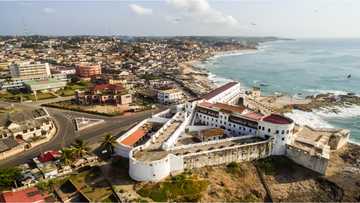What is the driest desert in the world? The 10 driest ranked
Did you know that roughly one-third of the land on Earth is arid or semi-arid? These areas, known as deserts, can reach incredibly high or low temperatures, receive little to no precipitation, and have sparse vegetation. Because of this, there isn't much life there because plants and animals find the environment hostile. You might not be aware that some deserts are drier than others. So what is the driest desert in the world?

Source: Getty Images
The arid climate subtype, also called the desert climate, has a significant excess of evaporation over precipitation. These climates typically have bare, rocky, or sandy surfaces that are dry and don't hold much moisture, so any rainfall they do get quickly evaporates. Even though deserts don't get much rain, sporadic downpours can result in flash floods.
What is the driest desert in the world?
From the Atacama in Chile to the Pelican Point in Namibia, the world has its fair share of barren areas. Discover the ten driest deserts in the world, ranking from the driest.
1. Atacama – Average rainfall: 15 mm (0.6 in) per year

Source: Getty Images
The Atacama is the world's driest non-polar desert. It is also the world's largest fog and true hot desert that receives less precipitation than the polar ones.
So, why is the Atacama desert so dry? According to the Global Weather & Climate Center, Atacama's astonishingly low precipitation can be attributed to several factors. They include the subtropical high, a double rain shadow, and the cold ocean current running up South America's west coast.
The Atacama desert temperatures are comparatively mild throughout the year, with the average temperature being about 63 degrees F (18 degrees C). But is the Atacama drier than Sahara? Yes, it is. The Atacama is the world's driest place, second only to the polar deserts.
2. Namib – Average rainfall: 10 mm (0.39 in) per year

Source: Getty Images
The Namib is the driest desert in Africa and is found in Namibia and southwestern Angola. It stretches 1,200 miles (1,900 km) along Namibia's Atlantic coast, named after this place.

Read also
Egypt's New Administrative Capital has a 93,440-capacity stadium and plans to host the 2030 World Cup And 2032 Olympics
But what causes the Namib desert to be so arid? According to the New World Encyclopedia, aridity is caused by the descent of dry, warm air from the east, cooled by the cold Benguela current along the coast. The warm, dry upper layer keeps the cool, humid air from rising and forming clouds.
3. The Sahara – Average rainfall: 76 mm (3 in) per year

Source: Getty Images
The Sahara is the world's largest hot desert, encompassing nearly all of northern Africa and covering an area of approximately 3.3 million square miles (8.6 million sq km).
Why doesn't it rain in the Sahara Desert? According to Live Science, the descending air prevents clouds from forming, resulting in very little rain falling on the land below.
4. The Taklamakan – Average rainfall: 40 mm (1.57 in) per year

Source: Getty Images
The Taklamakan desert is China's hottest, driest, and one of the world's most arid and desolate landscapes. According to NASA, parts of the Tarim Basin, surrounded on three sides by mountain ranges and dried by the resulting rain shadow, receive no more than 10 millimetres (0.4 inches) of rain annually.
5. The Mojave – Average rainfall: 51 to 152 mm (2 to 6 in) per year

Source: Getty Images
The Mojave is North America's driest desert. Its dry summers, which create a harsh environment during the hottest months, are a defining feature. The famous landscape, primarily found in southern Nevada and southeastern California, is home to nearly 2,000 unique plants, including the favourite Joshua trees only found in the Mohave.
Why is Mojave so dry? According to Blue Planet Biomes, while some rain falls on the mountains, most of it is evaporated by the hot air before reaching the ground. The rain shadow effect causes the Mojave to be one of the world's driest landscapes.
6. Death Valley Desert – Average rainfall: 55 mm (2.2 in) per year

Source: Getty Images
Death Valley is an arid valley in eastern California, bordering the Great Basin Desert in the northern Mojave. During the summer, it is the hottest place on the planet. According to the National Park Service, Death Valley is North America's hottest and driest place.
On 10 July 1913, the world's highest air temperature of 134°F (57°C) was recorded at Furnace Creek.
7. The Arabian Desert – Average rainfall: 100 mm (3.9 in) per year

Source: Getty Images
The Arabian is one of the hottest and largest, with sand covering most of its surface. According to Bayut, the Arabian is hot and dry, reaching 133°F (56.1°C). Among the reasons for this hot and dry climate is the Indian summer monsoon season, which affects the regional weather patterns.
8. Dasht-e Lut (The Lut Desert) – Average rainfall: 100 mm (3.9 in) per year

Source: Getty Images
Dasht-e Lut is a large salt desert in the Iranian provinces of Kerman, Sistan and Baluchestan. Scientists have measured the surface of its sand at temperatures as high as 70.7 °C (159.3 °F), making it one of the world's driest and hottest locations.
According to NASA, seven years of satellite temperature data show that the Lut is the most desirable place on the planet.
9. The Thar (Great Indian Desert) – Average rainfall: 100 to 500 mm (4 to 20 in) per year

Source: Getty Images
The Thar, also known as the Great Indian Desert, is an arid region in the northwestern Indian subcontinent that spans 200,000 square kilometres in India and Pakistan. According to Britannica, the Thar can reach temperatures of up to 123 °F (51 °C) at its hottest, which is hot most of May and June.
The arid subtropical climate is caused by its latitude's persistent high pressure and subsidence. The summer monsoon winds that bring rain to be much of the subcontinent tend to bypass the Thar to the east.
10. The Chalbi – Average rainfall: 150 mm to 350 mm (6 to 13.8 in) per year

Source: Getty Images
The Chalbi desert is Kenya's hottest and driest region. It is a rain-shadow landscape with an annual rainfall of between 150 mm to 350 mm. The part has two dry and two rainy seasons, but rain is erratic, and some years the area barely receives any rainfall.
According to Time and Date, average daytime temperatures in the Chalbi range from 109 F (43 C) to 115 F (46 C), while nighttime temperatures drop to around 57-59 F (14 -15 C).
What is the driest place on Earth?
According to Universe Today, the McMurdo Dry Valleys of Antarctica are the driest place on Earth. For nearly 2 million years, there has been no precipitation in the valley. The lack of rain in this area is due to katabatic winds. Gravity pulls these winds down and away from the valleys because they are so heavy with moisture from the mountains.
Frequently asked questions
- What are the 2 driest deserts in the world? According to Pedal Chile, The McMurdo Dry Valleys and the Atacama is the world's driest.
- Where is the driest desert in the world located? It is located in Antarctica (The McMurdo Dry Valleys).
- What is the name of the driest desert in the world? The Atacama in Chile is the driest non-polar desert in the world.
- What is the driest desert in the world? The Atacama and The McMurdo Dry Valleys in Antarctica hold the top positions of the aridest land on Earth.
- Is Death Valley hotter than the Sahara? No, not really. Despite Death Valley having cold winters, it still has recorded higher temperatures in the summer than the Sahara. However, the Sahara has recorded a consistently higher temperature than Death Valley.
- What are the 2 hottest deserts in the world? The Lut in eastern Iran and The Sahara in Eastern Morocco hold the record of the hottest desert on Earth.
What is the driest desert in the world? The Atacama in Chile is the hottest and driest place on the planet. Other locations that hold the record include the Sahara, Mojave, and the McMurdo Dry Valleys in Antarctica.
Yen.com.gh published an intriguing article about the world's ten most unique underwater statues. These one-of-a-kind underwater statues will blow you away if you think you've seen everything. They are artificial wonders found worldwide, each with its meaning.
Discover what these artistic marvels are and where to find them. Also, learn about the artists who created these magnificent sculptures and their reasons for placing them underwater.
Source: YEN.com.gh







